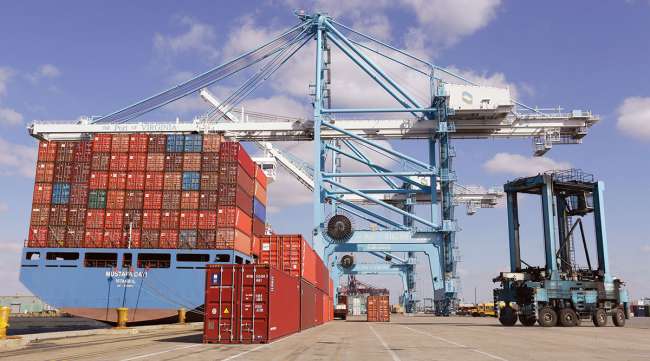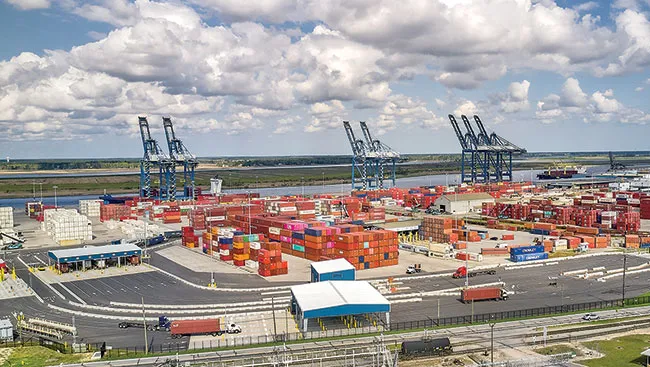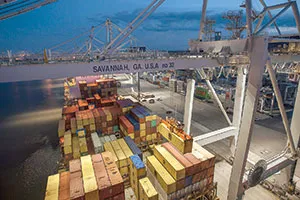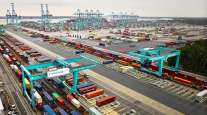Port Authorities Look to Make the Right Adjustments

[Stay on top of transportation news: Get TTNews in your inbox.]
In efforts to improve the supply chain system, U.S. port operators are utilizing advancements in infrastructure and technology to accommodate bigger ships and manage more cargo. Projects include construction or expansion of roads, bridges and rail to ease congestion in ports, enhance supply chain efficiency, and reduce carbon emissions.
Information technology is increasingly being brought to bear to provide enhanced visibility and monitoring of the supply chain, some port officials and supply chain experts said. The Port of Long Beach offers a continuous AI-powered “congestion index” provided by GoComet, a technology company specializing in logistics and supply chain management, allowing players in the chain to monitor and react to fluctuating circumstances affecting their cargo movements.
As part of a $1.2 trillion federal infrastructure bill signed by President Joe Biden in 2021, U.S. ports are receiving billions in funding for revitalization. Cary Davis, president and CEO of the American Association of Port Authorities, said seaports are adapting “with deeper and wider channels, as well as new landside projects, thanks to strong federal infrastructure investments.”
Davis cited shore power systems, renewables and “cutting-edge technology” as among innovations that port authorities are implementing.
Some of the port projects predate the federal funding actions, or are funded by other programs, such as the POLB’s Middle Harbor Redevelopment project, a 10-year effort that opened in August 2021. Starting with two old terminals, the project culminated in a 300-acre facility powered largely by electricity. The port said the facility can handle up to 3.3 million 20-foot-equivalent units annually. The investment came to nearly $1.5 billion for infrastructure, plus another $700 million in cargo-handling equipment, computer and software systems, and workforce training, the port said.
Noel Hacegaba, chief operating officer for the POLB, called that and other future capital expenditures underway, “our big-ship ready campaign.” He explained, “When the shipping lines decided, 15 years or so ago, to upsize their vessels, that put pressure on ports like ours to ensure that we have the infrastructure and the installations in our facilities to accommodate these ships.”
He pointed to additional infrastructure improvements, including the Long Beach International Gateway Bridge, which opened in October 2020, and a recently completed $25 million project, known as the Fourth Track at Ocean Boulevard, that added a rail line.
Hacegaba said the port began several years ago to prepare for electric trucks. He noted that of 21,000 trucks in the port’s registry, 112 are battery-powered, zero-emission vehicles. The port’s “working goal” is to have 100 public chargers for heavy-duty electric trucks by 2027. Currently, there are two public stations in operation at the port’s terminal access center, used for drayage trucks.
Additionally, WattEV, a firm that works with fleets and shippers in building EV infrastructure, has 13 dual-port chargers, for a total of 26 charging spaces, with plans for more, the port said. POLB also has leases with 4Gen Digital and Forum Mobility to install as many as 72 more public charging stations.
Check out Transport Topics' updated Top 50 list of the largest freight transportation companies in the world and explore how these companies are re-evaluating their supply chains. Tune in above or by going to RoadSigns.ttnews.com.
Investments in infrastructure and technology have been in full swing for other U.S. ports, such as the Port of Camden, North Carolina Ports Authority, Georgia Ports Authority and Virginia Port Authority with several projects completed, near completion or planned.
Last year, the U.S. Department of Transportation announced grants totaling more than $703 million through the Maritime Administration’s Port Infrastructure Development Program, which DOT said was made possible by the bipartisan infrastructure law and additional congressional appropriations. The grants are funding 41 port projects designed to improve supply chain reliability by increasing port capacity and enhancing efficient operations while reducing port emissions and generating jobs, DOT said.

The South Gate Container Complex opened at the Port of Wilmington in North Carolina in February 2022. (Keith Lanpher/North Carolina State Ports Authority)
The Port of Camden in New Jersey was granted $25 million to restore a “functionally obsolete and structurally deficient truck route,” 3 miles long, from Interstate 676 to the port, DOT said. The project includes truck turning radius improvements, new stormwater drainage and improved street lighting, striping and new signage.
“Carriers, shippers and consignees are looking for solutions in the supply chain that provide real-time visibility of cargo movements and speed to market,” said Doug Vogt, chief operating officer for the North Carolina State Ports Authority, adding that they are invested heavily in infrastructure projects and system integrations.
More than $350 million was allotted for infrastructure improvement to accommodate the largest vessels, Vogt said, listing aspects of the investment: berth expansion, turning basin expansion, larger Neopanamax cranes, increased air-draft clearance, a new container gate complex and new terminal operating systems.
Neopanamax refers to size limits of bigger ships that can travel through the expanded Panama Canal since new locks opened in 2016. “The Neopanamax cranes that were added are electric powered, replacing older diesel-powered cranes,” Vogt said.
NC Ports implemented Navis N4, its new web-based terminal operating system, to streamline operations and to keep the port-user community “well informed as to the status and availability of their cargo,” Vogt said. A new community access portal provides visibility into the NC Ports system and allows the trucking community to “pre-advise” their truck transactions — ensuring ahead of time that there will be no issues with an intended truck visit at the terminal. “This reduces any trouble [with] transactions for truckers, and streamlines our gate operations,” he explained.

The Port of Savannah. (Stephen B. Morton/Georgia Ports Authority)
In March, the Georgia Ports Authority announced that it would spend $170 million on 55 hybrid- engine rubber-tired gantry cranes to outfit the Port of Savannah’s Ocean Terminal, which it is redeveloping into an all-container facility.
The Port of Virginia is investing in Virginia Inland Port and Richmond Marine Terminal to expand capacity and reconfigure some operations. The port is investing more than $18 million in the two projects. The investment is part of a $1.4 billion Gateway Investment Program that focuses on expanding the port’s capabilities and modernizing operations, Stephen A. Edwards, CEO and executive director of the Virginia Port Authority, said in a statement. The project is scheduled for completion in 2024.
Still Challenges Ahead
In January, a coalition including the Harbor Trucking Association and California Trucking Association asked the ports of Los Angeles and Long Beach to work with “motor carrier stakeholders” to create a pilot program for “a single, interoperable, complexwide truck appointment system.”
Matt Schrap, CEO of HTA, and Eric Sauer, CEO of CTA, observed in the letter, “Currently, motor carriers are forced to work between several different platforms to secure appointments.
“There is not a single, interoperable system to locate appointment availability for future bookings in the [port] complex,” they said in the letter. “Nor is there a central location to aggregate appointments once they have been booked.”
A single appointment system would result in lower costs and greater productivity across the 12 container terminals in the port complex, they said. With one universal booking platform, “motor carriers will no longer expend resources and time navigating as many as seven unique appointment systems for container movement at the harbor complex,” they said. Schrap said in a phone call in early October that there had been little movement on the proposal for a pilot program.
Appointments for trucks are not necessary at the Georgia Ports Authority, said Susan Gardner, vice president of operations. Motor carriers can obtain a PIN for a container pickup as much as 72 hours in advance, but there is no set time at which they must arrive. Truckers can receive a PIN for a container move as little as 10 minutes before arrival, Gardner said.
The 72-hour notice enables GPA to groom the stacks to ensure quick service from yard cranes. Approximately 99% of container moves at the Port of Savannah are “pre-advised” in this manner, Gardner said.
PINs are recommended for empty containers and export container delivery, but not required.
This process also allows truckers to learn if a container is not yet available because it hasn’t been unloaded from a vessel, or if there is a hold by U.S. Customs and Border Protection, for instance.
Want more news? Listen to today's daily briefing above or go here for more info
The Port of Savannah offers a nine-day window for the reception of export containers. GPA locks in that date, so that motor carriers are not turned away at the gate, even if a vessel’s arrival slips to a later day. Truck gates are open from 4 a.m. to 6 p.m. Monday through Friday, and from 8 a.m. to 5 p.m. on Saturdays. GPA’s truck gates are managed through the Navis N4 terminal operating system.
Walter Kemmsies, a former longtime employee within the GPA who now is a consultant at the Kemmsies Group, said that some ports that seek to expand are constrained because there is limited “industrial [zoned] real estate” nearby. Kemmsies noted that some ports had overcome that limitation by developing inland or dry ports — sites to which containers can be moved out of the port proper, to then be picked up by motor carriers or moved out by rail.
The GPA opted for a different approach just this month, submitting an application to build a 395-acre cargo terminal for the Port of Savannah on land that the GPA owns on a 2,000-acre island in the middle of the Savannah River.






